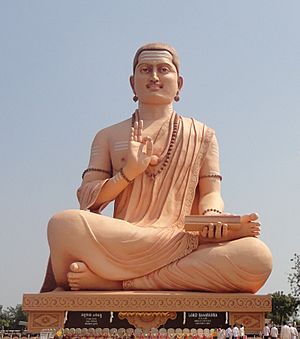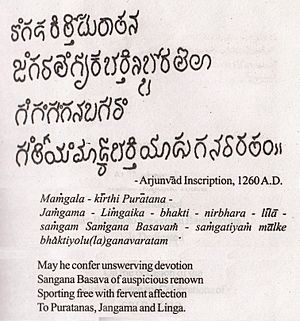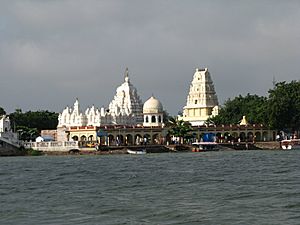Basava facts for kids
Quick facts for kids Basava |
|
|---|---|
 |
|
| Religion | Hinduism (Lingayatism) |
| Sect | Lingayat (Sharana) |
| Known for | Socio-religious reforms, Anubhava Mantapa, Vachana literature, Women empowerment movement in South India, Founder of Lingayatism |
| Personal | |
| Born | 1131 CE Basavana Bagewadi, Kalyani Chalukya Empire now in Vijayapura district, Karnataka, India |
| Died | 1196 CE (aged 64–65) Kudalasangama, Hoysala Empire now in Bagalkote district, Karnataka, India |
| Religious career | |
| Literary works | Vachanaas |
| Occupation | statesman, poet, social reformer, philosopher, chief minister of Bijapur province ("ವಚನಗಾರರು") |
Basava, also known as Basaveshwara or Basavanna, was an important leader in India during the 12th century. He was a statesman, a deep thinker, and a poet. Basava also worked as a social reformer, helping to change society for the better. He was part of the Lingayat movement, which focused on devotion to the god Shiva.
Basava lived when the Kalyani Chalukya and Kalachuri kings ruled in Karnataka, India. He became very influential during the time of King Bijjala II. Basava shared his ideas through his poems, which are called Vachanaas.
He believed that all people were equal, no matter their gender or social background. Basava was against old superstitions and rituals. He introduced the Ishtalinga necklace, which has a small image of the Shiva Liṅga. Everyone could wear this necklace as a reminder of their devotion to Shiva. Basava strongly believed in ahimsa, which means non-violence. He spoke out against both human and animal sacrifices.
As a chief minister, Basava created new public places like the Anubhava Mantapa. This was a "hall of spiritual experience" where men and women from all walks of life could meet. They would openly discuss important questions about life and spirituality.
Some traditional stories say Basava started the Lingayat faith. However, many modern experts believe he helped to revive and strengthen a tradition that already existed. Early writings about Basava's life include the Basavarajadevara Ragale by Harihara and the Basava Purana by Palkuriki Somanatha. Basava's writings are mostly in the Kannada Language and are known as Vachana Sahitya. He is also called Bhaktibhandari, meaning "the treasurer of devotion."
Contents
Basava's Early Life
Basava was born in 1131 CE in a town called Basavana Bagewadi in northern Karnataka. His parents, Maadarasa and Madalambike, were a traditional Hindu family who worshipped Shiva. They named him Basava, which is a Kannada form of the Sanskrit word Vrishabha. This name honored the Nandi bull, who is Shiva's carrier, and the local Shiva worship.
Basava grew up in Kudalasangama, a town in northwest Karnataka. It is located near the Krishna and Malaprabha rivers. He spent 12 years studying at a Hindu temple there. This temple was a Shaivite school, meaning it focused on the worship of Shiva.
Basava married his cousin, Gangambike. Her father was the prime minister for King Bijjala. Basava started working as an accountant for the king's court. When his uncle passed away, the king asked Basava to become the chief minister. The king also married Basava's sister, Nagamma.
As chief minister, Basava used government funds to support social and religious changes. He focused on bringing back the worship of Shiva and helping spiritual leaders called Jangamas. In the 12th century, he started the Anubhava Mantapa. This was a public meeting place where people from all backgrounds, men and women, could come together. They discussed spiritual, economic, and social issues. Basava wrote poems in the local language to share his ideas. His teachings, like Káyakavé Kailása (meaning "Work is Worship"), became very popular.
Basava's Writings
Basava is known for several important works, especially within the Veerashaiva Lingayat community. These include various Vachana poems. Some of these are the Shat-sthala-vachana, which talks about the six steps to spiritual freedom, and Kala-jnana-vachana, which contains predictions.
Stories About Basava's Life
The Basava Purana is a long poem about Basava's life. It was first written in Telugu in the 13th century by Palkuriki Somanatha. A Kannada version was written in the 14th century by Bhima Kavi. These books are very important to the Veerashaiva Lingayat faith.
Other stories about Basava include the Mala Basava-raja-charitre from the 15th century and the Vrishabhendra Vijaya from the 17th century. Both are in Kannada.
It's important to know that many poems and stories about Basava were written long after he died. This means that some details might have changed over time as they were passed down.
Basava's Philosophy and Beliefs
Basava grew up in a family that worshipped Shiva. As a leader, he inspired a new spiritual movement called Virashaivas. This name means "ardent, heroic worshippers of Shiva." This movement was connected to the Bhakti movement in South India, especially the Shaiva Nayanars traditions from the 7th to 11th centuries.
Basava promoted a way of worship that did not need temples or rituals led by priests. Instead, he taught people to worship Shiva directly and personally. This was done by wearing small icons and symbols, like a tiny linga. This way, Shiva's presence was with everyone, all the time. It also meant that gender, social class, or caste did not matter. Basava's poems, like Basavanna 703, show his strong belief in equality for men and women. They also show a strong sense of community.
In his poems, Basava often talked about Sthavara and Jangama. Sthavara means "what is static or standing," like temples and old books. Jangama means "what is moving or seeking," like work and open discussions.
Basava believed that people should always work on their own spiritual growth to find true understanding. He encouraged using the local language, Kannada, for all spiritual talks. This way, everyone could understand spiritual ideas without needing experts to translate. His ideas were similar to the Protestant movement in Europe. Basava's philosophy was about seeing your own body and soul as a temple. Instead of building a temple, he suggested being the temple. His main ideas involved a guru (teacher), a linga (personal symbol of Shiva), and a jangama (someone who is always learning and moving).
In the 12th century, Basava created the Anubhava Mantapa. This was a place for people to gather and discuss spiritual ideas. Anyone from society, men and women, could join. Devoted followers of Shiva shared their spiritual achievements and poems in the local language. Basava questioned old rituals and the idea of God being separate from oneself. He said that the true God is "one with himself, self-born."
While Basava did not like rituals, he encouraged using symbols. These included wearing the Istalinga (a necklace with a personal linga), Rudraksha seeds or beads, and applying Vibhuti (sacred ash on the forehead). These were meant to be constant reminders of one's devotion and beliefs. Another way to strengthen faith was using the six-syllable mantra, Shivaya Namah, or Om Namah Shivaya.
The Path to Freedom
The Basava Purana describes discussions between Basava and his father. Both believed that ancient Hindu texts were important. However, they disagreed on the best marga (path) to a good and free life. Basava's father preferred traditional rituals. Basava, however, believed in the path of direct, personal devotion, called bhakti.
Basava said that the path of devotion goes "beyond six systems of philosophy." He believed it was the true way to see everything. He taught that the guru (teacher) is full of kindness and helps you find God within yourself. The six-syllable mantra is very powerful. Wearing certain things like hair locks, ashes, and rudraksha beads helps a person escape the cycle of birth and death. This path leads to freedom in this very lifetime.
Roots in Ancient Philosophy
Some scholars connect Basava's ideas to the Vedanta school of Hindu philosophy. They suggest his Lingayat beliefs are a form of qualified nondualism. This means that the individual Atma (soul) is part of God, and there is no difference between Shiva and the soul. Shiva is one's soul, and one's soul is Shiva. This view is similar to the ideas of the 11th-century philosopher Ramanuja.
Basava's Legacy and Impact
Modern studies show that Basava was a poet and thinker in the 12th century who helped to revive and energize an existing spiritual tradition. The community he helped create is known as the Sharanas. This community is mainly found in Karnataka, but its members have also moved to other parts of India and even overseas. By the end of the 20th century, about 10 million people in Karnataka were Veerashaiva Lingayats, following the traditions Basava championed.
Social Reformer
Basava taught that every human being is equal, no matter their caste or social group. He believed that all kinds of manual labor were equally important. He said that a true saint was defined by their behavior, not by their birth. The Sharanas community welcomed anyone, regardless of their birth occupation. People could convert and become part of the larger family of Shiva devotees. Then, they could choose any job they wanted. Basava strongly believed in ahimsa, or non-violence. He firmly spoke out against all forms of sacrifices, whether human or animal.
Bringing Together Hindu Traditions
Basava is known for bringing together different spiritual ideas of his time. The Virashaivism movement, which Basava led, tends to believe in one main god, Shiva. However, it also strongly recognizes the unity of the Ultimate Reality. This is seen as a blend of Ramanuja's ideas and Shankara's ideas, called Shakti-Vishishtadvaita. This combines the idea of one ultimate reality with beliefs about divine energy (Shakti).
Basava's tradition sees a person's spiritual journey as a six-stage process called Satsthalasiddhanta. This process helps a person grow from being a simple devotee to reaching complete union with God, which is called liberation or mukti. Basava's approach is different from Adi Shankara's. Basava emphasized the path of devotion, while Shankara focused on the path of knowledge.
Experts like Jessica Frazier say that Basava created a movement that combined "Vedic with Tantric practice." It also brought together the idea of one ultimate reality (monism) with strong devotion (Bhakti devotionalism).
Symbols and Icons
Basava encouraged people to wear the Ishtalinga. This is a necklace with a small pendant that holds a Shiva linga. He realized that "Arive Guru," meaning "one's own awareness is his/her teacher." Many poets of his time described him as Swayankrita Sahaja, which means "self-made."
Monuments and Recognition
- The former President of India, Abdul Kalam, unveiled Basaveshwara's statue in the Parliament of India on April 28, 2003.
- Basaveshwara was the first person from Kannadiga (Karnataka) to have a special coin made in his honor. This was to recognize his work in social reforms. The former Prime Minister of India, Dr. Manmohan Singh, released these coins in Bengaluru.
- On November 14, 2015, the Prime Minister of India, Narendra Modi, unveiled Basaveshwara's statue. It is located along the Thames river in Lambeth, London, facing the UK Parliament.
- The Basava Dharma Peetha has built a 108-foot (33-meter) tall statue of Basava in Basavakalyana.
Images for kids
See also
 In Spanish: Basava para niños
In Spanish: Basava para niños









